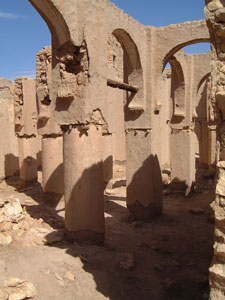|
|
|
|
A Treacherous Valley
Leo documents these treacherous practices. In his days the "Ziz hills" were inhabited by Berber tribes who lived in Ksars, or fortified villages.
Since the Muslim conquest of Morocco in the 8th century, the country was been inhabited both by Berbers (the original dwellers, that Leo refers to as "Africans"), and the Arabs- different nomadic or sedentary tribes who emigrated from Egypt or from the Gulf to settle in Morocco. The Arabs he is referring to here were the tribes who lived in the desert, just South of the Ziz Valley, and staffed most of the caravans (either as guides or camel drivers). This enmity amongst races had a great impact on commerce and trade:
 To
monitor this traffic of Arabs and Caravans through the Ziz Valley, the
Zenaga tribes people built fortified villages on top of canyon passes.
These Ksars enabled them to see miles into the Valley floor (see picture):
"This
town was built to serve as a fortress to control the route into Numidia
[the desert]."
(Leo, 318) To
monitor this traffic of Arabs and Caravans through the Ziz Valley, the
Zenaga tribes people built fortified villages on top of canyon passes.
These Ksars enabled them to see miles into the Valley floor (see picture):
"This
town was built to serve as a fortress to control the route into Numidia
[the desert]."
(Leo, 318)
But all this trouble was well worth it, as it made the difference between rich and poor. As Leo says:"Amongst these inhabitants, some are vassal to the Arabs, others are independent. The first are so poor that they have to beg, the others are tremendously rich as they control the passage on the route from Fes to Sijilmassa, and exert a high payment from all merchants." (Leo, 426)
|